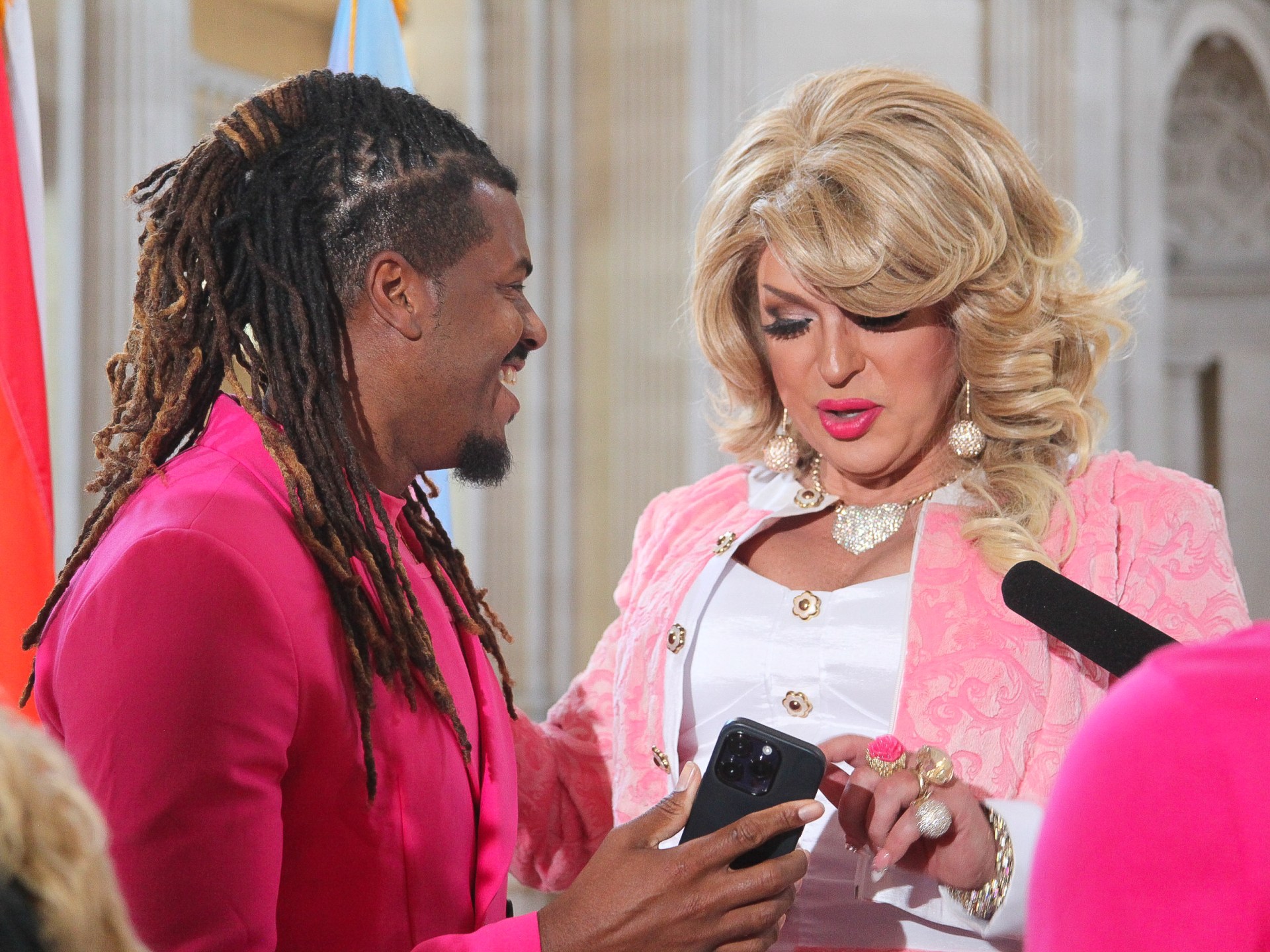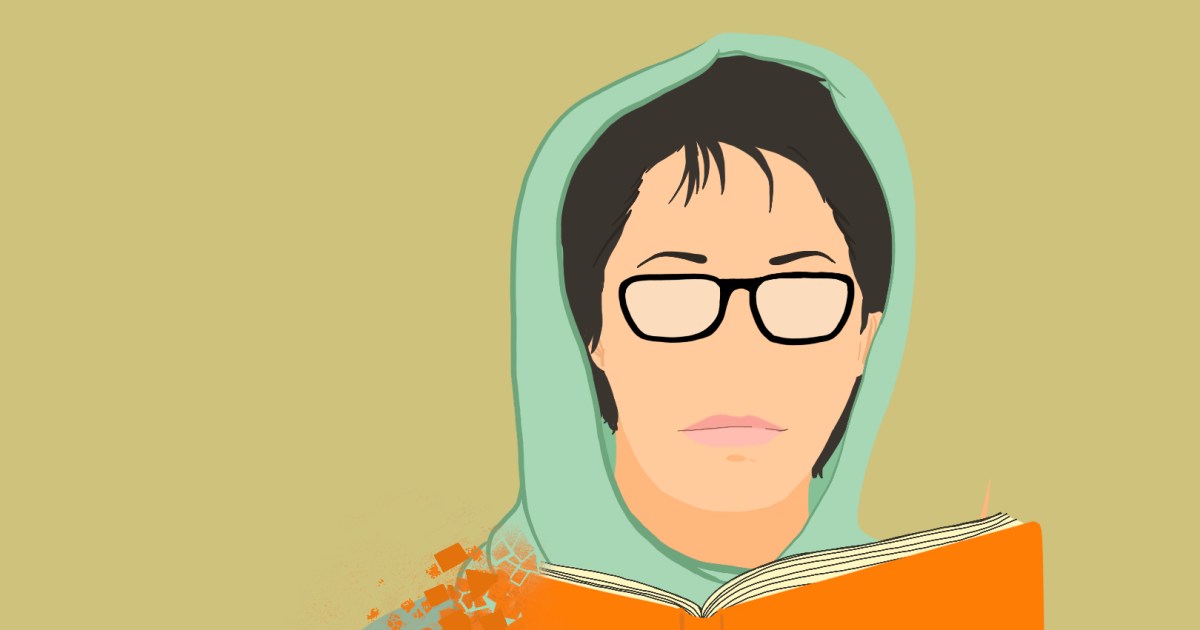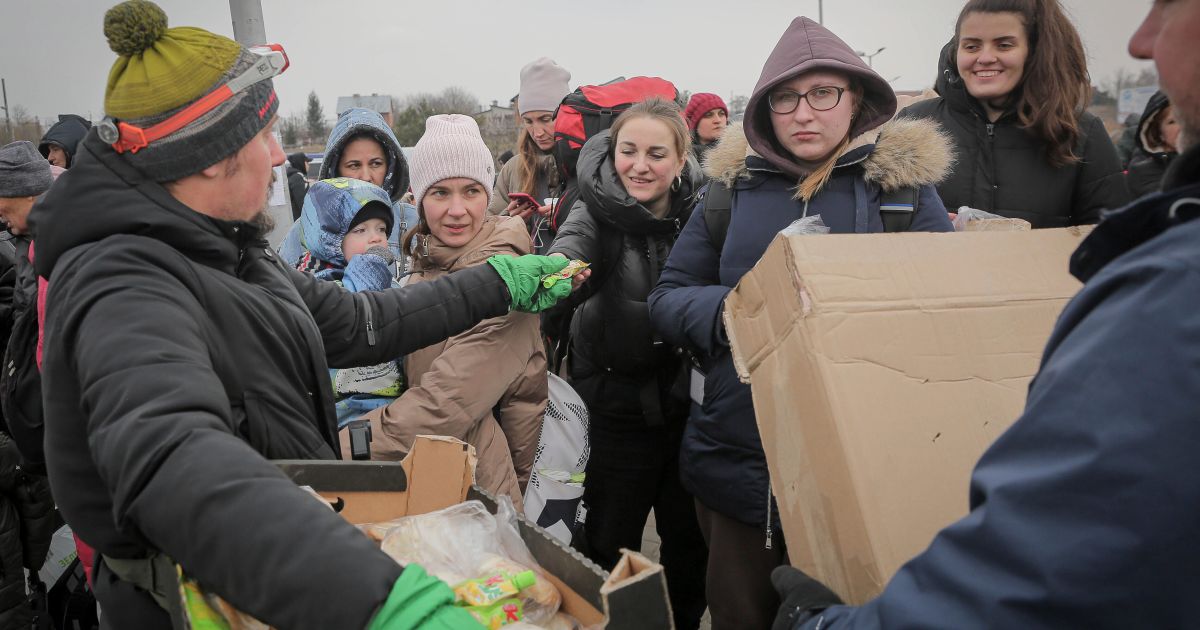San Francisco’s new drag laureate wants you to be ‘more fabulous’ | LGBTQ News
San Francisco, California, US – A nimbus of golden curls, teased into a bouffant, she strolled up to the wooden podium, all eyes trained on her.
But D’Arcy Drollinger, 54, was undaunted. It was the start of San Francisco’s Pride Month festivities — the annual celebration of the city’s LGBTQ+ community — and Drollinger was the guest of honour.
Her job? To serve as an ambassador for one of the city’s most iconic art forms: drag.
As legislation spreads across the United States targeting the LGBTQ+ community, San Francisco has taken a first-of-its-kind step by naming an official drag laureate to represent the city.
For 18 months, Drollinger will act as a spokesperson, championing LGBTQ+ rights and leading community events, all while incarnating a larger-than-life blonde bombshell.
“It is an amazing experience to be standing here with my fellow community leaders and kicking off Pride 2023 as the first drag laureate of San Francisco — and the world,” Drollinger told a crowd assembled on the mayor’s balcony in city hall.

Dancing from birth
But in an interview afterwards with Al Jazeera, Drollinger readily admitted, “I didn’t set out to get here.” Drag was not a choice so much as something that came naturally.
“I was dancing from the moment I was born. I was a show person,” Drollinger explained. Drollinger uses “she” pronouns when in character, and “he” when not.
Born in San Francisco to an anthropologist and an artist, Drollinger remembered watching the film Mary Poppins as a young child — and feeling inspired by its stern but eccentric heroine.
“I gravitated to these female characters,” Drollinger said. “I wanted to dress like Mary Poppins. And my parents, being free-spirited, went to the thrift store and bought me a little dress and umbrella and a pair of high heels. And I ran around the house as Mary Poppins.”
But work soon called Drollinger’s parents away from San Francisco. Part of Drollinger’s childhood was spent in Samoa, before the family eventually settled in the small gold-rush town of Nevada City, California.
There, junior high school was “tough”, Drollinger recalled. “I was very unpopular. I was teased constantly. And there were people telling me I was gay before I had even thought about it.”
Theatre, however, offered a sanctuary. And by high school, Drollinger was writing and staging his own plays — despite the fact that there was no drama department to rely on. Drollinger ransacked thrift stores for costumes, and sets were hand-painted on stretched canvas.
“I didn’t know how to type. I wrote the scripts all by hand and went and had them Xeroxed,” Drollinger recounted.

Drag as microscope
But in spite of the difficulties, theatre proved to be Drollinger’s calling: “Once you try and take on something that seems impossible and you do it, it gets very addicting.”
Drollinger followed his passion for performance into adulthood. He toured with a post-punk rock band and worked as an assistant on the original Broadway productions of Hairspray and The Producers.
But in the world of drag — and San Francisco — Drollinger found a home for both his playwriting skills and his acting chops. He moved back in 2010, and by 2015, he and two business partners had converted a former bathhouse into their very own club space, Oasis.
He has since become its sole owner, navigating the club through the coronavirus pandemic with creative ventures like a drag telethon and “Meals on Heels”, a food delivery service that kept performers employed even as stages shuttered.
“Someone was asking the other day: Why is drag important?” Drollinger said. “And it’s like: Why is theatre important? Why is film important? Why is dance?”
All those art forms are mirrors for truth, but in the exaggerated performance style of drag, Drollinger found a unique perspective to share with audiences.
“Drag blows things up in sometimes comical, sometimes dramatic ways. You look at things under a microscope in a sense,” Drollinger explained. “You can see things in a different way.”

A mainstream entertainment
But the very thing that makes drag powerful can also make it “disquieting” to some viewers, according to drag historian Joe E Jeffreys.
“Drag un-tethers sex from gender. And that is not a concept that some people find comfortable,” he explained.
While some drag practitioners trace the origins of the art form as far back as ancient Greece — where men played female roles — Jeffreys believes the roots of modern drag more accurately lie in 19th- and 20th-century vaudeville.
“In fact, some of the highest-paid performers in vaudeville were male and female impersonators,” Jeffreys said.
Styles ranged from the camp caricatures of Bert Savoy to the naturalistic performances of Julian Eltinge, who disappeared into the women he portrayed — only to burst the illusion by plucking off his wig at the end of his shows.
“I think we need to consider that drag has always been part of the mainstream entertainment,” Jeffreys said. “There used to be any number of — and there still are — large nightclubs that presented lavish female impersonation shows primarily to heterosexual audiences.”
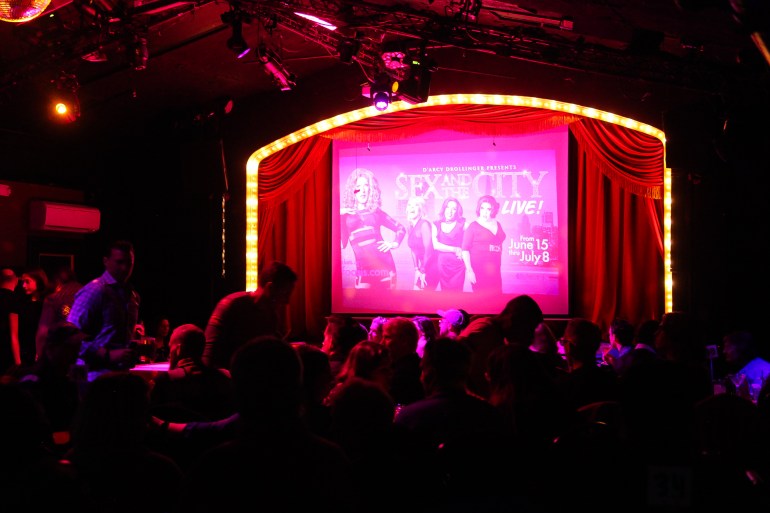
But just as drag has its precursors, so too does anti-drag legislation. In the 19th century, more than 40 US cities had laws restricting “cross-dressing” — including San Francisco. An 1863 ordinance banned individuals from appearing in public in “dress not belonging to his or her sex”.
“This is nothing new,” Jeffreys said of the current spate of anti-drag legislation sweeping the US.
On June 3, a federal judge struck down one of the most wide-ranging bans in Tennessee, which would have barred “male or female impersonators” from appearing on public property or in the presence of children.
Critics feared its broad language would have criminalised not just drag performance but also transgender and nonbinary identities.
“What’s really going on is they’re trying to legislate how gender is presented in society — that non-conforming genders should not be visible,” Jeffreys said. Other states, including North Dakota, Texas and South Carolina, have considered similar legislation.
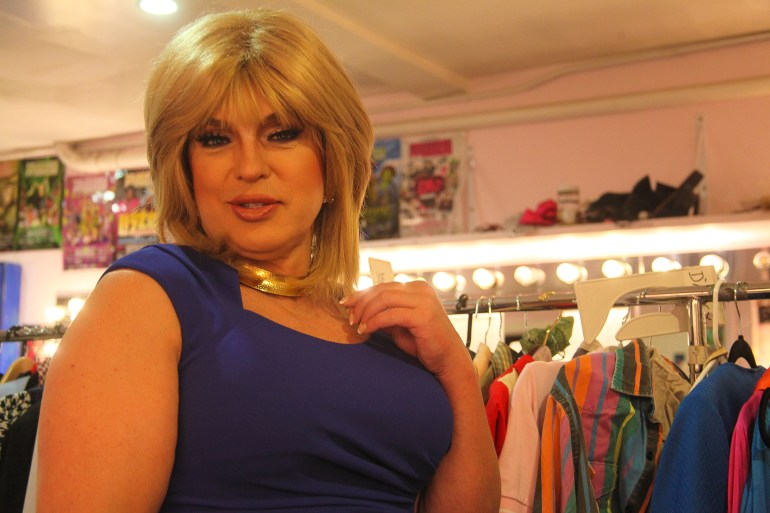
Drag, a political force
The proposed bans come at a time of heightened visibility for drag, buoyed by the success of TV shows like RuPaul’s Drag Race.
Honey Mahogany is an alumna of that show. Now, she chairs the San Francisco Democratic Party. She sees the two experiences as a natural fit.
“To me, drag has always been at the forefront of the queer political movement,” Mahogany said.
That history, she explained, began with figures like José Sarria, a drag performer who, in 1961, became the first openly gay person to run for public office in the US.
And it continued with the Compton’s Cafeteria riot and the Stonewall Uprising — acts of resistance against police violence in San Francisco and New York, respectively.
“Those things were led by gender non-conforming people — drag queens, trans people — at that time because I think they had the least to lose,” Mahogany said. “It was, for us, life or death.”
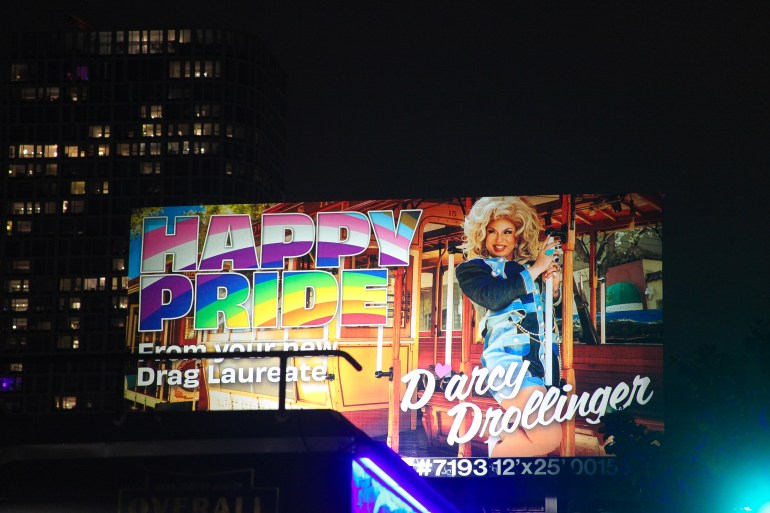
Drag, at that time, had a regional flavour.
In the South, it was shaped by pageant traditions, while in New York, ballroom culture and Broadway exerted their sway. But San Francisco drag, Mahogany said, was more “punk rock” — less glam and more transgressive, with styles like “genderf***” that eschewed traditional binaries.
Still, despite its rebellious nature, San Francisco’s drag scene was not insulated from outside pressures. Mahogany remembers that, during the fight to legalise same-sex marriage in the US, drag became “almost a dirty word”.
“There was a strong push towards assimilation in the LGBTQ community, to prove we were like everyone else, that we wanted to get married and have kids,” she said. That “sanitised” version of the LGBTQ community did not involve the outré performance styles of drag.
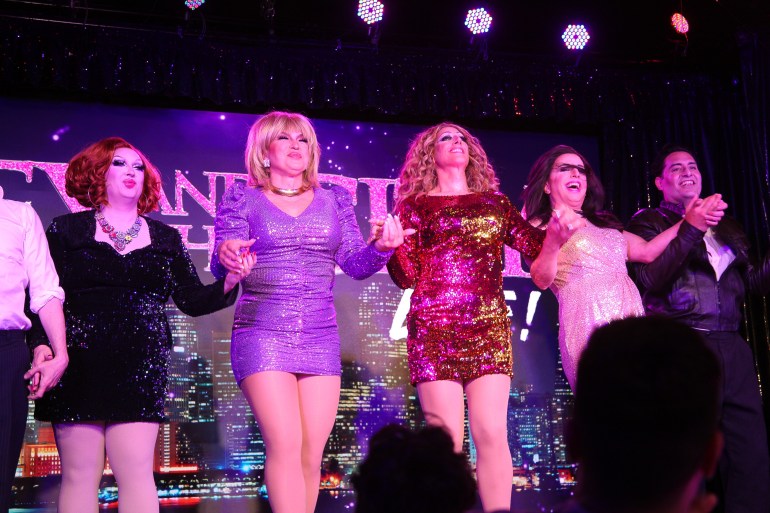
An ‘easy target’
But that perspective has changed over the last decade, Mahogany said. “We have swung in the other direction, and drag has taken centre stage and is very much celebrated right now within the LGBTQ community.”
Unfortunately, she added, that has also made performers “an easy target to attack”, even in the famously left-leaning San Francisco Bay Area.
Last June, at the San Lorenzo Library, members of the far-right group Proud Boys disrupted a Drag Story Hour, a read-along event designed to promote child literacy. Earlier this month, protesters returned to the library to denounce another Drag Story Hour reading.
Mahogany herself leads Drag Story Hour at the San Francisco branch where she received her first library card, right across from her pre-school. Her latest reading went off “without incident”, she said — but the library did have two security guards on hand, just in case.
Even at Drollinger’s club, Oasis, heightened security has become the norm.
“I have to have metal detectors now at my nightclub. It sucks,” Drollinger said. “We have to live with this constant threat of intimidation by these people that are trying to squash a few people trying to bring joy into other people’s lives.”

But Juliano Innocenti, a nurse practitioner who performs as Shalita Corndog with the outreach group Sisters of Perpetual Indulgence, believes the drag laureate position can help turn the tide of hate.
“The creation of a drag laureate says so much with so little,” Innocenti said. He predicts the role will trigger a “trickle effect”, fostering similar drag laureate positions in other cities.
“It will just be a matter of time before we see them pop up in Chicago and New York and Los Angeles and Miami and Dallas and some of these progressive cities,” Innocenti explained. “And then that will start to trickle into some of the smaller ones, including places in conservative areas.”
Already, West Hollywood is on the verge of naming a drag laureate, and New York has previously weighed launching its own version.
For Drollinger though, the goal for the next 18 months is simple: Inspire people “to walk through the world a little more fabulous”.
“If you can just be a little more authentic and a little more fabulous, you inspire others around you to be more fabulous,” Drollinger explained.
“And if everyone’s a little more fabulous, there’s a little less room in their hearts and in their heads for anger and hostility and prejudice and violence.”

